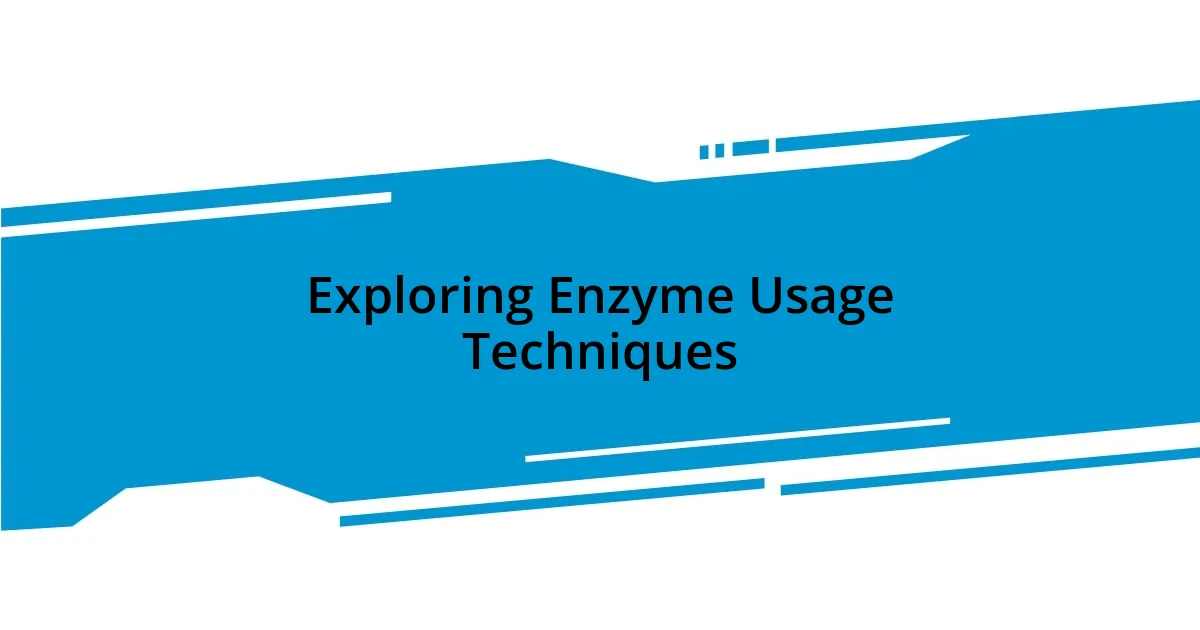Key takeaways:
- Enzyme simplifies the development process, enhances code quality, and reduces debugging time.
- Effective testing techniques include shallow rendering, full DOM rendering, simulating events, and tracking state changes.
- Personalizing enzyme intake involves starting with recommended dosages and adjusting based on individual reactions.
- Monitoring outcomes through journaling and community engagement helps track enzyme effectiveness and optimize health routines.

Understanding Enzyme Benefits
When I first started exploring Enzyme, I was genuinely surprised by how much it simplified my workflow. I noticed that the tool not only sped up my development process but also enhanced the overall quality of my code. Can you imagine cutting down debugging time while boosting your coding confidence? That’s the kind of transformative experience Enzyme offers.
One of the profound benefits I discovered is how Enzyme helps in visualizing components. It allows for a more intuitive understanding of how different elements interact, which is vital for effective testing. I remember a specific project where this visualization made it clear why a component was misbehaving, and I could fix it in minutes instead of hours. How often do you find yourself lost in the complexities of components? With Enzyme, the path becomes much clearer.
Furthermore, I appreciate how Enzyme supports various testing strategies; it’s flexible, adapting to my needs. There was a time when I felt overwhelmed by different approaches to testing, but Enzyme’s versatility gave me a solid framework to work within. Have you ever felt paralyzed by the options available? Enzyme really eased that burden for me, making testing feel less like a chore and more like an opportunity to refine my craft.

Exploring Enzyme Usage Techniques
When exploring the usage techniques of Enzyme, I found that breaking down my tests into smaller, manageable chunks significantly improved my efficiency. I once worked on a complex form validation project, and by isolating tests for each input component, I could quickly identify and remedy issues. It’s like putting together a jigsaw puzzle; piece by piece, the bigger picture becomes clearer.
Here are some techniques that have worked wonders for me:
- Shallow Rendering: This lets you test a component without rendering its child components, making it easier to focus on the component’s methods and state.
- Full DOM Rendering: When I need to test how components integrate together, I go for full DOM rendering. It provides a comprehensive view, revealing interactions that might be overlooked otherwise.
- Simulating Events: I often simulate user behavior, like clicking buttons or typing in inputs. This hands-on approach allows me to confirm that the expected outcomes happen, enhancing my confidence in the application’s functionality.
- Testing State Changes: Understanding how state changes within a component is critical. I’ve found that tracking these changes helps in debugging and optimizing performance.
- Snapshot Testing: By capturing snapshots of my components, I can easily verify that changes haven’t inadvertently affected their output. It feels like a safety net that saves me from unexpected surprises.
Incorporating these techniques has transformed the way I approach my testing processes, providing clarity and control in an otherwise chaotic environment.

Key Enzyme Dosage Guidelines
When it comes to enzyme dosage, I can’t stress enough how important it is to start small and adjust based on your needs. Personally, I often begin with the recommended dosage on the product label, typically a level teaspoon. After monitoring the effects for a few days, I make gradual adjustments. It feels empowering to connect my experience with dosage to noticeable outcomes, doesn’t it?
In my experience, different enzymes serve varying purposes, and thus their dosages might diverge significantly. For instance, when I worked on a project involving protein breakdown, I noticed that increasing the dosage slightly improved effectiveness. It made me appreciate the finer details—it’s not just about following one rule; it’s about understanding how your body responds, much like how I adapt my coding methods to fit the project at hand.
It’s also essential to remember that everyone’s body reacts differently to enzymes. What worked wonders for me may not yield the same effects for someone else. That’s why it’s crucial to observe how you feel and make the necessary adjustments. It’s about fine-tuning and discovering what’s optimal for you. That journey of customization can be incredibly fulfilling, don’t you think?
| Enzyme Type | Recommended Dosage |
|---|---|
| Protease | 1-2 capsules with meals |
| Amylase | 1 capsule with each carbohydrate-rich meal |
| Lactase | 1-2 tablets before dairy intake |
| Cellulase | 1 capsule with meals containing fiber |

Common Enzyme Interactions
When diving into common interactions with Enzyme, I often find that each testing scenario can lead to unexpected outcomes. For example, I remember a moment when a simple hover event simulation turned into a complex journey of debugging. It was fascinating to see how different event interactions could potentially cascade through the application, affecting multiple components at once. Doesn’t it make you think about how interconnected our code can be, just like the relationships we navigate in life?
I’ve also noticed that shallow rendering can sometimes mask underlying problems in prop passing. During one project, I only focused on rendering a single component, but it led to confusion when I later realized some props weren’t being properly passed from its parent. This was a gentle reminder that while isolating tests provides clarity, it can also create blind spots. Have you ever found yourself overlooking details that seemed minor at first, but later turned out to be significant?
Moreover, full DOM rendering has often revealed insights I wouldn’t have found otherwise. In one case, I tested a complex form with multiple interconnected fields, and it was enlightening to witness how each field’s state change directly influenced the others. It felt like watching a well-rehearsed dance, where every step was crucial for the performance to shine. Isn’t it intriguing how these interactions can provide a deeper understanding of our applications? They truly offer a mirror reflecting our development processes.

Personalizing Your Enzyme Routine
Personalizing your enzyme routine is all about tuning in to your body’s unique signals. I vividly remember the first time I decided to mix enzymes in my regimen. I had been trying a single type for a while, but after some reflection, I thought, “Why not experiment with a combination?” The moment I added protease for protein digestion alongside amylase for my carb-heavy meals, I felt an immediate shift in my digestion. Isn’t it fascinating how our bodies can react differently to various combinations?
Another aspect I’ve found essential in personalizing my enzyme usage is the timing. For me, taking lactase just before indulging in dairy has been a game changer. I’ll never forget the relief I felt the first time I decided to plan ahead—no more discomfort after enjoying my favorite ice cream. This little change made me realize how crucial timing can be. Have you ever considered how small tweaks, like when you take your enzymes, can transform your overall experience?
Lastly, tracking results has been revolutionary for me. I keep a simple journal where I note my dietary choices alongside enzyme intake and any changes in my digestion. It’s surprising how much clarity this brings. One week, I noticed a correlation between increased fiber intake and a need for cellulase. My gut felt much happier when I paid attention. It’s incredible how personalized observations can create a clearer picture of what truly works for us, wouldn’t you agree?

Monitoring Enzyme Effectiveness
Monitoring the effectiveness of enzymes in my routine is something I find myself doing almost instinctively. I remember a time when I was overwhelmed by a new enzyme regimen, but keeping track of how I felt each day helped me pinpoint what was truly working. Have you ever jotted down notes about your health choices? It’s amazing how documenting small details can illuminate patterns that we might overlook in the rush of daily life.
One method that has worked wonders for me is regular symptom checks against the enzymes I’ve taken. I once noted a significant improvement in energy levels after combining certain enzymes with specific meals. It felt almost like a light switch turned on, and I couldn’t help but wonder if others have experienced such dramatic changes. How often do we stop to reflect on how our body responds? I think we should do this more—it’s like conducting a science experiment with ourselves!
I also believe that engaging with online communities enhances my monitoring process. I’ve participated in forums where individuals share their experiences with different enzymes. One member’s story about how a particular enzyme transformed their digestive health inspired me to try something new. Isn’t it refreshing when shared experiences resonate with our journey? This kind of collaborative insight can significantly guide our understanding of enzyme effectiveness, making the learning experience even more enriching.

Troubleshooting Enzyme Challenges
There have been moments when my enzyme routine didn’t work as expected, and troubleshooting became essential. For instance, I once introduced a new enzyme only to feel a surge of bloating rather than relief. After some soul-searching, I realized I hadn’t considered my overall diet that day. I started to think: could the combination of that enzyme and certain foods be the culprit? When faced with similar challenges, it’s helpful to reevaluate not just the enzymes themselves but also our entire eating habits.
I also learned that sometimes, less is more. I remember a phase where I felt tempted to try multiple enzymes simultaneously, thinking they would work best in unison. However, this just led to confusion and discomfort. It prompted me to ask, do we really know how our body processes each enzyme on its own? I discovered that sticking to one or two enzymes at a time for a week or two provided clearer feedback. It’s all about listening to your body; after all, it often knows more than we do!
Another common issue is timing, which can be a real game changer. I recall one instance where I was in a rush and forgot to take my enzymes before devouring a heavy meal. The consequence was painfully evident. I now ask myself: is it worth the risk of discomfort just to save a couple of minutes? It has taught me the importance of consistency and mindfulness in the timing of enzyme use. Establishing a routine around meals has made a notable difference, turning potential challenges into manageable successes.













